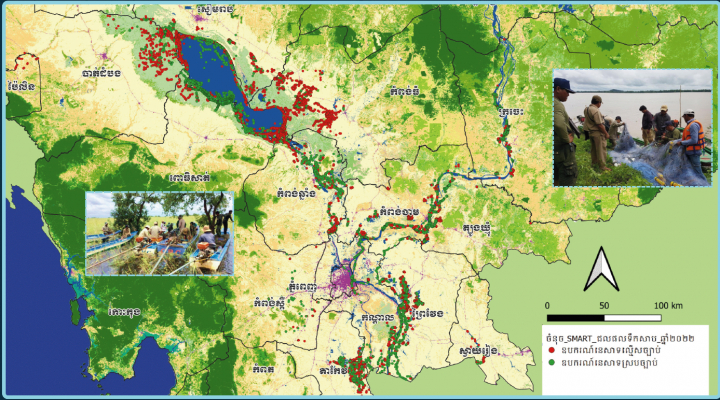
Implementing SMART to Prevent and Suppress Fishing Offenses
The Royal Government of Cambodia, through the Ministry of Agriculture, Forestry and Fisheries, is committed to ensuring the sustainable abundance of the country’s fisheries resources to support food security and improve livelihoods. The Fisheries Administration (FiA) plays a leading role in managing, conserving, and developing these resources. A key element of this effort is the effective enforcement of the Fisheries Law, with a strong focus on preventing and suppressing fishing offenses.
Under the FAO CAPFISH-Capture Programme and financial support from the European Union, the FiA has adopted the Spatial Monitoring and Reporting Tool (SMART), to enhance fisheries law enforcement. SMART is used to collect, analyze, and report data, as well as to support planning for fisheries monitoring and inspections—thereby improving the efficiency and impact of enforcement activities.
With technical support from both FAO and the Wildlife Conservation Society (WCS), the SMART system has been customized (including Khmer language support) to meet the specific operational needs for recording patrol activities such as patrol locations and times, types of fishing gear encountered, transport of fisheries-related products, and the monitoring of flooded forest areas. All data collected through SMART is stored in a centralized database managed by FiA and is used by both FiA Inspectorates and Cantonments to inform inspection and enforcement planning.
From 2020 to 2024, technical training on SMART was provided to fisheries enforcement officers at both the national and sub-national levels. As a result, the implementation of SMART has led to the recording of approximately 45,000 inspection cases per year, contributing significantly to the achievements of the enforcement targets and the improvement of the management, conservation, and development of fisheries resources.
Annual Report on Inspection of Inland Fisheries by SMART Tool in 2023
Annual Report on Fishing and Related Inspection by SMART Tool for Inland Fisheries in 2022
Annual Report on Fishing and Related Inspection by SMART Tool for Inland Fisheries in 2021
Annual Report on Fishing and Related Inspection by SMART Tool for Inland Fisheries in 2020
Annual Report on Fishing and Related Inspection by SMART Tool for Marine Fisheries in 2023
Annual Report on Fishing and Related Inspection by SMART Tool for Marine Fisheries in 2022
Annual Report on Fishing and Related Inspection by SMART Tool for Marine Fisheries in 2021
Annual Report on Fishing and Related Inspection by SMART Tool for Marine Fisheries in 2020
SMART Patrolling Handbook
